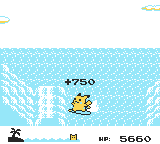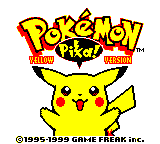Pokémon Yellow beta: Difference between revisions
m (r2.6.5) (Robot: Adding it:Pokémon Giallo beta) |
m (Text replacement - "}}{{Project" to "}} {{Project") |
||
| (41 intermediate revisions by 18 users not shown) | |||
| Line 1: | Line 1: | ||
{{move|Development leftovers of Pokémon Yellow}} | |||
{{incomplete|2=Pikachu cries leftovers, unused graphics from Pikachu Surf Game, other leftovers, tcrf is a good reference}} | |||
{{game|Yellow}} is a special edition of the [[Generation I]] games. It introduced the [[friendship]] system, which was improved and completed in {{game|Gold and Silver|s}} and has since become a staple of the [[core series]]. It also added other features, such as [[walking Pokémon]], which are exclusive to Pokémon Yellow and {{game|HeartGold and SoulSilver|s}}, and the [[Pikachu's Beach]] minigame. Some aspects of the game's initial design did not make it to the final release, either due to time constraints or due to its heavy reliance and basis on {{game2|Red|Green|Blue}}. | |||
==Pre-release== | |||
===Evolution levels=== | |||
In a news article on [[Pokémon.com]] about upcoming Pokémon games, it was mentioned that Pokémon would evolve at different levels to what they would in {{game|Red and Blue|s}}.<ref>[http://web.archive.org/web/19990508114802/http://www.pokemon.com/news/outlook.html Pokémon.com - What's on the horizon in the world of Pokémon?] (archive)</ref> However, the game had already been released in Japan at the time, so this may have just been misinformation. | |||
==Post-release== | |||
===Hidden battle system=== | |||
Data exists for a {{pkmn|battle}} situation when the {{pkmn|Trainer}} has no {{OBP|Pokémon|species}}, though it isn't actually used when entering a battle with no Pokémon in the final release. In this case, selecting any option other than <sc>Run</sc> shows the message "''Hurry, get away!''" In the Japanese version, this dialogue is written in an "old man" dialect, so this may have been intended to be used for [[Professor Oak]] during the initial battle with the {{pkmn2|wild}} {{OBP|Pikachu|Yellow}} at the start of the {{player}}'s adventure, as the player has no Pokémon at that point. | |||
{{youtubevid|m2EVWpfLSQg|ChickasaurusGL|yellow}} | {{youtubevid|m2EVWpfLSQg|ChickasaurusGL|yellow}} | ||
== | ===Leftover music theme=== | ||
An unused | An unused music theme has been encountered in the internal data. It is not known where it would be used, but it is possible that it relates to the aforementioned "no Pokémon" {{pkmn|battle}} system. However, it is not stored in either the battle, overworld or [[cave]] soundbanks. It is located in the minigame and "special Trainer" ([[Jessie]] and [[James]]) soundbanks, where the [[Pikachu's Beach]] music is stored, which is partly why this track only exists in {{game|Yellow}}. | ||
{{youtubevid|GFGCRxmqMkA|ChickasaurusGL|yellow}} | {{youtubevid|GFGCRxmqMkA|ChickasaurusGL|yellow}} | ||
{{ | It may be worth noting that it closely resembles the battle music theme with Madake from ''BUSHI Seiryūden: Futari no Yūsha'' for the [[Super Nintendo Entertainment System|Super Famicom]], a game that [[Game Freak]] developed and released in January 1997 after the release of {{game|Red and Green|s}}, but before the Japanese release of Pokémon Yellow. | ||
{{youtubevid|KW76wYrjTCY|ChickasaurusGL|yellow}} | |||
===Scrapped Pikachu's Beach bonus score=== | |||
[[File:Pikachu's Beach Unused Bonus.png|thumb|right|200px|The unused +750 points score]] | |||
There is unused radness data for a score of +750 points in the [[Pikachu's Beach]] minigame. It is impossible to achieve this score, regardless of how many flips Pikachu does, or how they were performed. | |||
{{YouTubeVid|5XaYhKD2z7E|ChickasaurusGL|Yellow}} | |||
===Unused in-game trades=== | |||
The {{p|Butterfree}}-for-{{p|Beedrill}} [[in-game trade]] from {{game2|Red|Green|Blue}} remains.<ref>[https://iimarckus.org/i/trades/ In-game Trades]</ref> The Japanese version of {{game|Yellow}} kept the Beedrill's name from the Japanese Blue while the English version renamed it to '''<sc>Stinger</sc>'''. | |||
Two additional in-game trades were also planned but scrapped, probably to compensate for the removal of the in-game trades in [[Cerulean City]] and [[Vermilion City]]. One is a Pidgeot for Pidgeot trade while the other is a Mew for Mew trade. In the Japanese version of Yellow, both received Pokémon have the same nickname, まつみや ''Matsumiya''; however, in the English localizations, {{p|Pidgeot}} is nicknamed '''<sc>Marty</sc>''' while {{p|Mew}} is nicknamed '''<sc>Bart</sc>'''. | |||
===Default player and rival names=== | |||
The unused default names for {{ga|Red}} (<sc>[[Nintendo|Ninten]]</sc>) and {{ga|Blue}} (<sc>{{wp|Sony}}</sc>) remain unaltered.<ref>[http://acmlm.kafuka.org/board/thread.php?pid=18912#18912 Intresting and funny in Pokemon Red - Board 2]</ref> In the Japanese version, Blue's unused default name remains unaltered from {{game|Blue| (Japanese)}} while Red's was subtly altered by gaining an extra digit (ゲーフリ1).<ref>[https://iimarckus.org/i/default-names/ Default names]</ref> | |||
===Unused Pikachu Cries=== | |||
Pikachu's voice actress [[Ikue Otani]] recorded 42 cries for Pikachu but 16 of them go unused.<ref>[https://tcrf.net/Pok%C3%A9mon_Yellow Pokémon Yellow - TCRF]</ref> | |||
===Semi-unused yellow palette=== | |||
[[File:YellowTitle GBC unused.png|thumb|The Game Boy Color mode's yellow palette]] | |||
In Japanese Yellow on [[Game Boy Color]] mode, the game uses a yellow palette similarly to how Red, Green, and Blue use their respective red, green, and blue palettes. In Western Yellow, Game Boy Color mode instead uses the [[Super Game Boy]] palettes but with more saturated colors. | |||
The yellow palette from Japanese Yellow is used by Western Yellow in certain situations, like the [[Pikachu's Beach]] hi-score screen. It can be reinstated completely by modifying the ROM.<ref>[http://forums.glitchcity.info/index.php/topic,6459.msg200012.html#msg200012 Pokémon Yellow: SGB/GBC differences]</ref> | |||
{{clear}} | |||
==References== | |||
<references /> | |||
{{Beta|yellow}} | |||
{{Project Games notice}} | {{Project Games notice}} | ||
[[it:Pokémon Giallo beta]] | [[it:Pokémon Giallo beta]] | ||
Latest revision as of 06:38, 26 June 2024

|
It has been suggested that this article be moved to Development leftovers of Pokémon Yellow. Please discuss whether or not to move it on its talk page. |
Pokémon Yellow is a special edition of the Generation I games. It introduced the friendship system, which was improved and completed in Pokémon Gold and Silver and has since become a staple of the core series. It also added other features, such as walking Pokémon, which are exclusive to Pokémon Yellow and Pokémon HeartGold and SoulSilver, and the Pikachu's Beach minigame. Some aspects of the game's initial design did not make it to the final release, either due to time constraints or due to its heavy reliance and basis on Pokémon Red, Green, and Blue.
Pre-release
Evolution levels
In a news article on Pokémon.com about upcoming Pokémon games, it was mentioned that Pokémon would evolve at different levels to what they would in Pokémon Red and Blue.[1] However, the game had already been released in Japan at the time, so this may have just been misinformation.
Post-release
Hidden battle system
Data exists for a battle situation when the Trainer has no Pokémon, though it isn't actually used when entering a battle with no Pokémon in the final release. In this case, selecting any option other than Run shows the message "Hurry, get away!" In the Japanese version, this dialogue is written in an "old man" dialect, so this may have been intended to be used for Professor Oak during the initial battle with the wild Pikachu at the start of the player's adventure, as the player has no Pokémon at that point.
| |
| This video is not available on Bulbapedia; instead, you can watch the video on YouTube here. | |
Leftover music theme
An unused music theme has been encountered in the internal data. It is not known where it would be used, but it is possible that it relates to the aforementioned "no Pokémon" battle system. However, it is not stored in either the battle, overworld or cave soundbanks. It is located in the minigame and "special Trainer" (Jessie and James) soundbanks, where the Pikachu's Beach music is stored, which is partly why this track only exists in Pokémon Yellow.
| |
| This video is not available on Bulbapedia; instead, you can watch the video on YouTube here. | |
It may be worth noting that it closely resembles the battle music theme with Madake from BUSHI Seiryūden: Futari no Yūsha for the Super Famicom, a game that Game Freak developed and released in January 1997 after the release of Pokémon Red and Green, but before the Japanese release of Pokémon Yellow.
| |
| This video is not available on Bulbapedia; instead, you can watch the video on YouTube here. | |
Scrapped Pikachu's Beach bonus score
There is unused radness data for a score of +750 points in the Pikachu's Beach minigame. It is impossible to achieve this score, regardless of how many flips Pikachu does, or how they were performed.
| |
| This video is not available on Bulbapedia; instead, you can watch the video on YouTube here. | |
Unused in-game trades
The Butterfree-for-Beedrill in-game trade from Pokémon Red, Green, and Blue remains.[2] The Japanese version of Pokémon Yellow kept the Beedrill's name from the Japanese Blue while the English version renamed it to Stinger.
Two additional in-game trades were also planned but scrapped, probably to compensate for the removal of the in-game trades in Cerulean City and Vermilion City. One is a Pidgeot for Pidgeot trade while the other is a Mew for Mew trade. In the Japanese version of Yellow, both received Pokémon have the same nickname, まつみや Matsumiya; however, in the English localizations, Pidgeot is nicknamed Marty while Mew is nicknamed Bart.
Default player and rival names
The unused default names for Red (Ninten) and Blue (Sony) remain unaltered.[3] In the Japanese version, Blue's unused default name remains unaltered from Pokémon Blue while Red's was subtly altered by gaining an extra digit (ゲーフリ1).[4]
Unused Pikachu Cries
Pikachu's voice actress Ikue Otani recorded 42 cries for Pikachu but 16 of them go unused.[5]
Semi-unused yellow palette
In Japanese Yellow on Game Boy Color mode, the game uses a yellow palette similarly to how Red, Green, and Blue use their respective red, green, and blue palettes. In Western Yellow, Game Boy Color mode instead uses the Super Game Boy palettes but with more saturated colors.
The yellow palette from Japanese Yellow is used by Western Yellow in certain situations, like the Pikachu's Beach hi-score screen. It can be reinstated completely by modifying the ROM.[6]
References

|
This game-related article is part of Project Games, a Bulbapedia project that aims to write comprehensive articles on the Pokémon games. |


